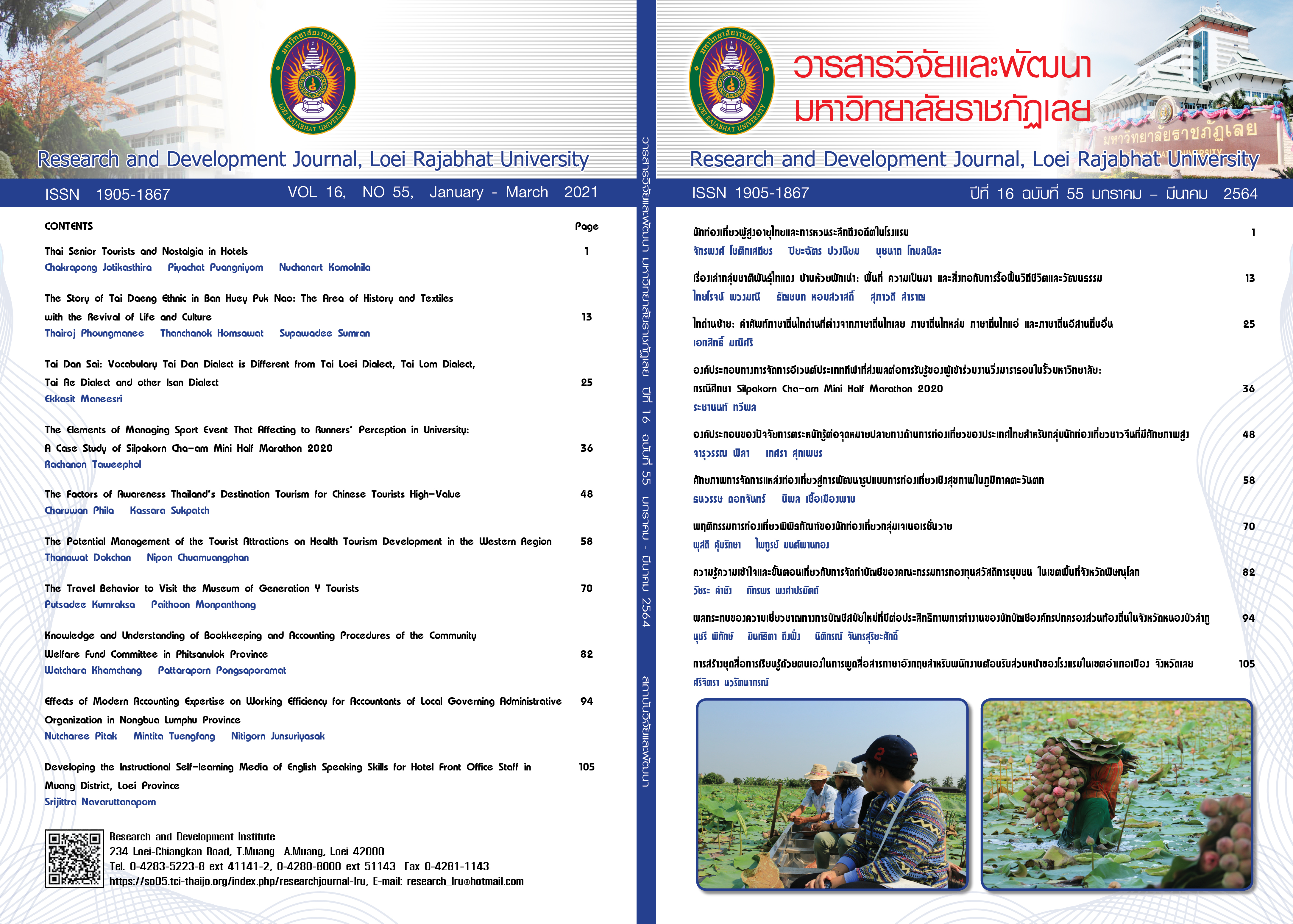The Potential Management of the Tourist Attractions on Health Tourism Development in the Western Region
Keywords:
health tourism, tourism management, western regionAbstract
This research aimed to study the health tourism attractions and its potential in the western region on health tourism development in 5 provinces area of Thailand, which are Nakhon Pathom Province, Ratchaburi province, Kanchanaburi province, Phetchaburi province and Prachuap Khiri Khan Province. Using a qualitative method research to study on field survey by yourself. Study tourism factors, according to the dimensions of the health tourist attractions in 5 areas of western region, which are quality of tourist attractions dimension, tourist safety dimension, basic tourism fundamental dimension, tourism management dimension and tourists’ attractions dimension.
The results revealed that there were 5 potential areas in western, that were 1. Mahasawat Community in Nakhon Pathom province has the potential of tourist attraction quality in the overall at a good level, 2. Lao Tuk Lak floating market in Ratchaburi province has the potential of tourist attraction quality in the overall at a moderate level, 3. Nong Rong Community in Kanchanaburi province has the potential of tourist attraction quality in the overall at a moderate level, 4. Nong Ya Plong Community in Phetchaburi province has the potential of tourist attraction quality in the overall at a good level and 5. Huaysatyai Community in and Prachuap Khiri Khan Province has the potential of tourist attraction quality in the overall at a good level. All of 5 areas are unique in natural resources and local culture. They are suitable for development to support health tourism according to the potential and linkage in all 5 destinations, the half-day, One day Trip and Two days one-night trip styles.
References
กรมสนับสนุนบริการสุขภาพ. (2562). รายงานการวิจัยเรื่อง รายงานผลการวิจัยและสำรวจข้อมูลด้านบริการสุขภาพและบริการเพื่อส่งเสริมสุขภาพของไทย ประกอบการจัดทำศูนย์ข้อมูลรองรับนโยบาย Medical Hub (รายงานการวิจัย). นนทบุรี: กองสุขภาพระหว่างประเทศ กรมสนับสนุนบริการสุขภาพ กระทรวงสาธารณสุข.
กองเศรษฐกิจการท่องเที่ยวและกีฬา. (2563, 22 มกราคม). สถานการณ์ด้านการท่องเที่ยวเดือนธันวาคม 2562. สืบค้นจาก https://bit.ly/34mx0JQ
ฐานิดา ทองมาแก้ว, อมรรัตน์ ช่วยศรี, รัชภูมิ จินะ, อัชฌาพร กว้างสวาสดิ์ และนพดล สายคติกรณ์. (2560). การประชาสัมพันธ์เว็บไซด์แบกเป้เที่ยวป่าละอู ด้วยสื่ออินโฟกราฟฟิค. The ASEAN Undergraduate Conference in Computing (AUC2), 5(1), 130-136.
ธารทิพย์ ขาวผ่องอำไพ และธีรศักดิ์ อุ่นอารมณ์เลิศ. (2553). ผลที่เกิดจากการท่องเที่ยวเชิงเกษตรที่มีต่อสุขภาวะทางสังคมของคนในชุมชนคลองมหาสวัสดิ์ อำเภอพุทธมณฑล จังหวัดนครปฐม. วารสารศิลปะศึกษาศาสตร์วิจัย มหาวิทยาลัยศิลปากร, 1(2), 100-113.
ปทิตตา ตันติเวชกุล. (2546). การท่องเที่ยวเชิงสุขภาพ. จุลสารการท่องเที่ยว, 22(11), 29-41.
ประพนธ์ เล็กสุมา และคณะ. (2562). แนวทางการพัฒนากิจกรรมการท่องเที่ยวเชิงสุขภาพในภูมิภาคตะวันตก. วารสารวิจัยและพัฒนา มหาวิทยาลัยราชภัฏเลย, 14(49), 20-30.
ยุพิน อุ่นแก้ว และโชคชัย สุเวชวัฒนกูล. (2560). การพัฒนาตัวบ่งชี้ความเป็นแหล่งท่องเที่ยวเชิงสร้างสรรค์. วารสารวิทยาลัยดุสิตธานี, 11(1), 1-15.
วิราสิริริ์ วสีวีรสิว์ และคณะ. (2558). ความเป็นไปได้และรูปแบบการจัดการการท่องเที่ยวเชิงสุขภาพในจังหวัดกาญจนบุรี. วารสารวิชาการ มหาวิทยาลัยอีสเทิร์นเอเชีย ฉบับวิทยาศาสตร์ และเทคโนโลยี, 9(2), 210-218.
ศูนย์ข้อมูลความรู้ ประชาคมเศรษฐกิจอาเซียน. (2555, 17 ธันวาคม). ภาพรวมการเปิดเสรีด้านการค้าขายของกับ AEC ที่มีผลกระทบต่อไทย. สืบค้นจาก http://www.thai-aec.com/32
สมบัติ กาญจนกิจ และคณะ. (2561). การพัฒนาศักยภาพอุตสาหกรรมการท่องเที่ยวเชิงสุขภาพของไทยเพื่อเป็นศูนย์กลางการท่องเที่ยวเชิงสุขภาพในเอเชีย. เอกสารข่าวสารงานวิจัยและพัฒนา, 17(187), 15-27.
Cai, L.A. (2002). Cooperative Branding for rural destinations. Annals of Tourism Research, 29(3), 720-742.
Downloads
Published
How to Cite
Issue
Section
License
ข้อความที่ปรากฎในวารสารฉบับนี้เป็นความคิดเห็นของผู้เขียนแต่ละท่าน สถาบันวิจัยและพัฒนา มหาวิทยาลัยราชภัฏเลย และกองบรรณาธิการ ไม่จำเป็นต้องเห็นด้วยและไม่มีส่วนรับผิดชอบใดๆ
สถาบันวิจัยและพัฒนา มหาวิทยาลัยราชภัฏเลย ขอให้ผู้อ่านอ้างอิงในกรณีที่ท่านคัดลอกเนื้อหาบทความในวารสารฉบับนี้






